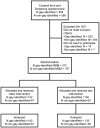Effect of an online video-based intervention to increase HIV testing in men who have sex with men in Peru
- PMID: 20454667
- PMCID: PMC2862715
- DOI: 10.1371/journal.pone.0010448
Effect of an online video-based intervention to increase HIV testing in men who have sex with men in Peru
Abstract
Background: Although many men who have sex with men (MSM) in Peru are unaware of their HIV status, they are frequent users of the Internet, and can be approached by that medium for promotion of HIV testing.
Methods: We conducted an online randomized controlled trial to compare the effect of HIV-testing motivational videos versus standard public health text, both offered through a gay website. The videos were customized for two audiences based on self-identification: either gay or non-gay men. The outcomes evaluated were 'intention to get tested' and 'HIV testing at the clinic.'
Findings: In the non-gay identified group, 97 men were randomly assigned to the video-based intervention and 90 to the text-based intervention. Non-gay identified participants randomized to the video-based intervention were more likely to report their intention of getting tested for HIV within the next 30 days (62.5% vs. 15.4%, Relative Risk (RR): 2.77, 95% Confidence Interval (CI): 1.42-5.39). After a mean of 125.5 days of observation (range 42-209 days), 11 participants randomized to the video and none of the participants randomized to text attended our clinic requesting HIV testing (p = 0.001). In the gay-identified group, 142 men were randomized to the video-based intervention and 130 to the text-based intervention. Gay-identified participants randomized to the video were more likely to report intentions of getting an HIV test within 30 days, although not significantly (50% vs. 21.6%, RR: 1.54, 95% CI: 0.74-3.20). At the end of follow up, 8 participants who watched the video and 10 who read the text visited our clinic for HIV testing (Hazard Ratio: 1.07, 95% CI: 0.40-2.85).
Conclusion: This study provides some evidence of the efficacy of a video-based online intervention in improving HIV testing among non-gay-identified MSM in Peru. This intervention may be adopted by institutions with websites oriented to motivate HIV testing among similar MSM populations.
Trial registration: Clinicaltrials.gov NCT00751192.
Conflict of interest statement
Figures
References
-
- UNAIDS. AIDS Epidemic Update. Geneva: Joint United Nations Programme on HIV/AIDS; 2007. Available: http://data.unaids.org/pub/EPISlides/2007/2007_epiupdate_en.pdf. Accessed 2010 March 10.
-
- Orellana ER, Picciano JF, Roffman RA, Swanson F, Kalichman SC. Correlates of nonparticipation in an HIV prevention program for MSM. AIDS Educ Prev. 2006;18(4):348–61. - PubMed
-
- Kusunoki L, Guanira J, Navarro C, Velasquez C. Report of Monitoring the declaration of commitment on HIV/AIDS 2005. 2005. Available: http://data.unaids.org/pub/Report/2006/2006_country_progress_report_peru.... Accessed 2010 March 10.
-
- Peru Country Progress Report UNGASS. 2008. Available: http://data.unaids.org/pub/Report/2008/peru_2008_country_progress_report.... Accessed 2010 March 10.
-
- Blas M. Web-based survey to assess risk behaviors for sexually transmitted infections and HIV among men who have sex with men from Peru. 2007. Master of Public Health Thesis. University of Washington.
Publication types
MeSH terms
Associated data
Grants and funding
LinkOut - more resources
Full Text Sources
Medical




